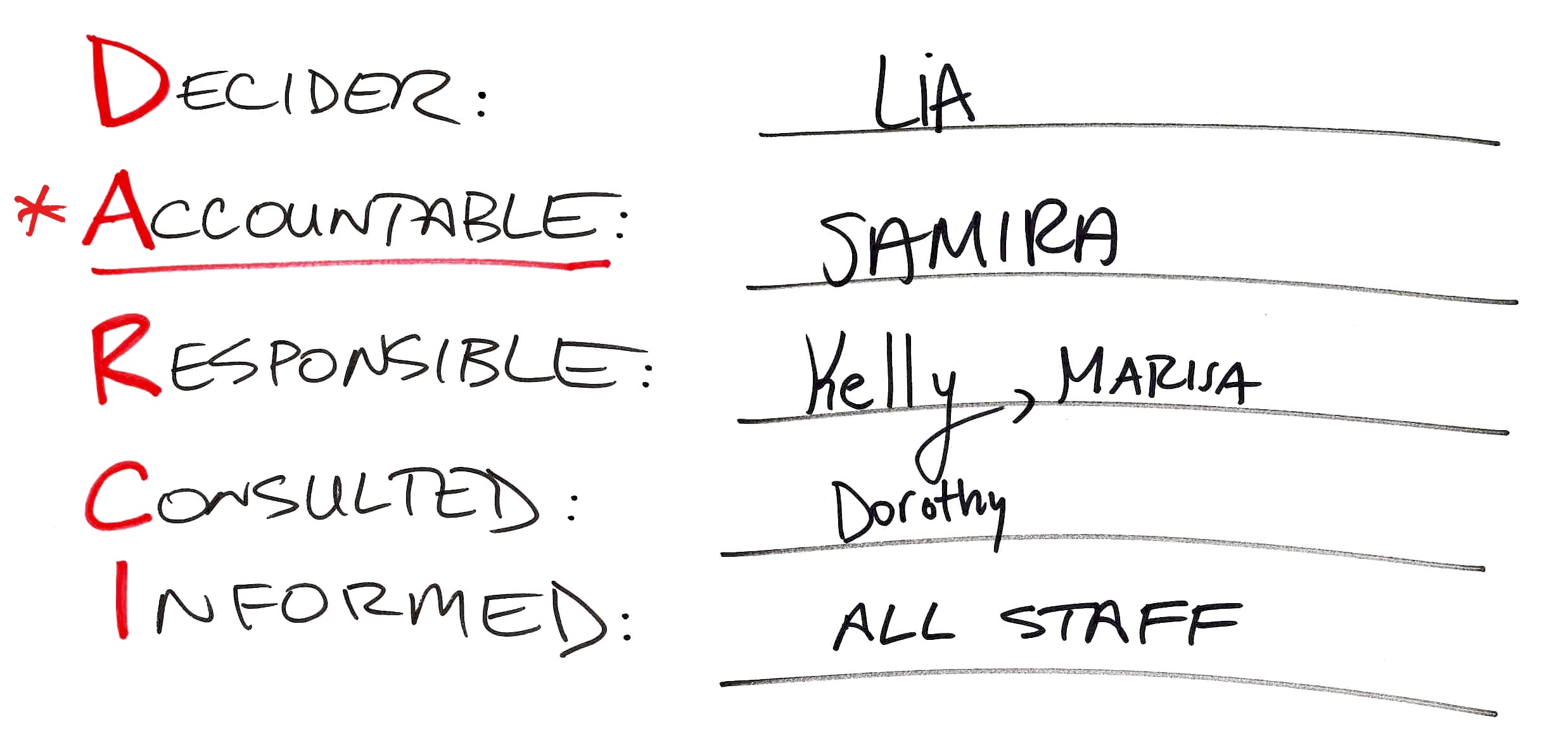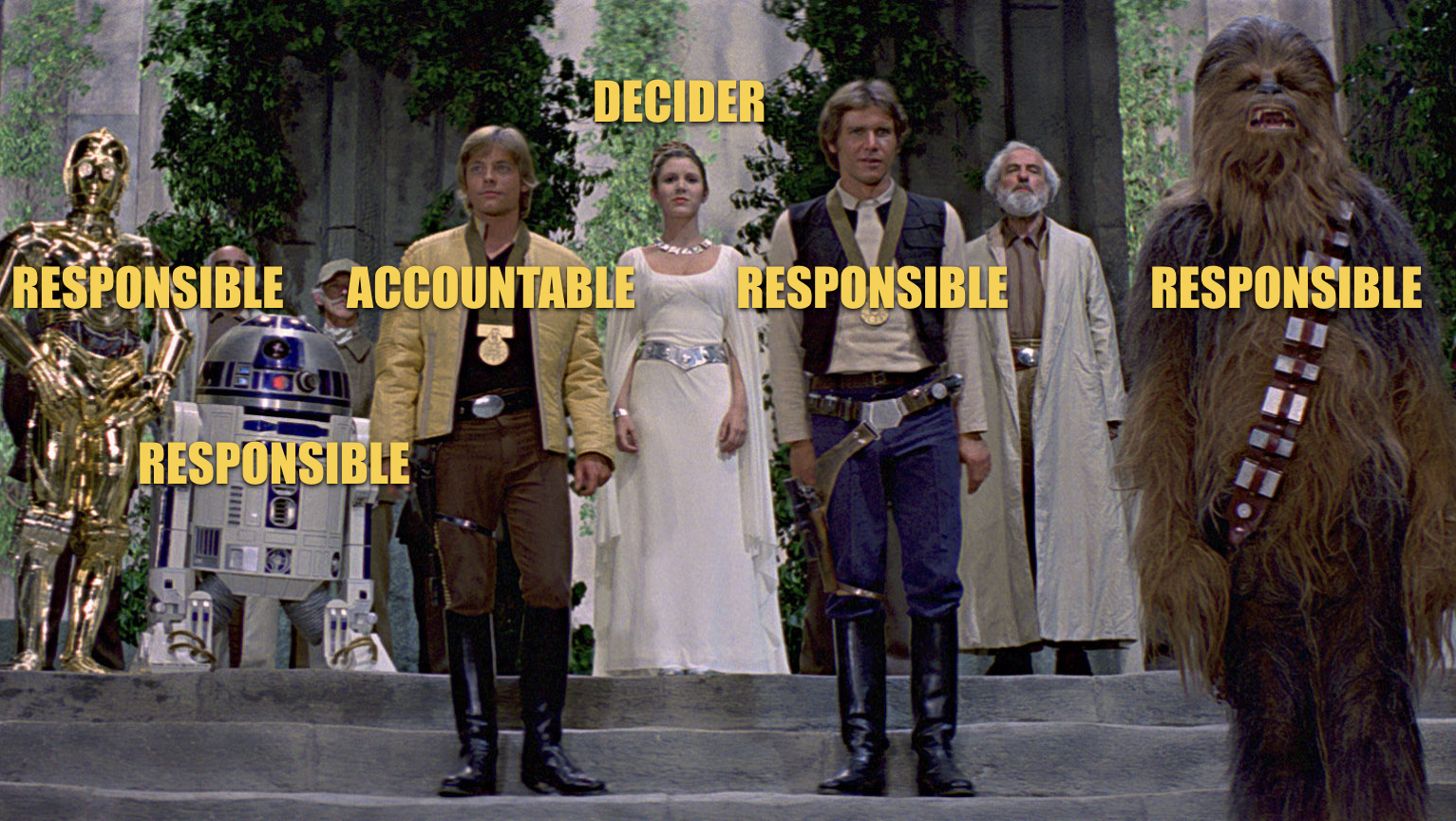Whenever you’re kicking off a new project or team objective, DARCI is like your geeky-but-secretly-cool best friend.
It’s a simple checklist you can use in 60 seconds or less to quickly align around “who’s doing what” on a given project, so that you don’t all run around smacking into each other like preschoolers playing soccer. It’s also a great way to quickly surface the brass tacks of power, decision-making and workload in a fast, transparent way that people appreciate.
What does “DARCI” stand for?
Decider, Accountable, Responsible, Consulted, Informed
How’s it work? Whenever you kick off a project, fill out this simple checklist together to clearly spell out who is…
- D= the DECIDER: the person or group who makes the final decisions about the work (eg, the Executive Director, the Board)
- A = ACCOUNTABLE: the one person accountable for making sure the work gets done (eg, the project manager)
- R = RESPONSIBLE: the people DOING the work (eg, the project team)
- C = CONSULTED: the people who’s opinions and advice will be sought (eg, advisors, other teams)
- I = INFORMED: the people informed about the work when it’s done (eg, all staff, the accounting team)
Put your DARCI list at the top of your project document. Or scrawl it on a post-it note at the staff retreat next to a new objective. Or call it out whenever you agree on an action item in a meeting. (“Ok, so who’s accountable on that one? And who’s responsible for doing the work?”) DARCI helps deliver a healthy dose of clarity and accountability fast.

“ACCOUNTABLE” is special, because there can be only one
Note that all the other roles can have several people or groups attached (e.g., the Decider for hiring a new designer might be both the Executive Director and the Board.) But the “A” is different — there can be only one. Having just one human clearly accountable ensures things don’t fall through the cracks. The A doesn’t have to do all the work, but they are accountable for making sure it gets done. It’s a key role to get right.
A simple example
Imagine you’re kicking off a big home renovation project. Your DARCI might look look something like this:
- DECIDER: You. You’re the last word on what color the new drapes will be, where to plant the rosebush, etc.
- ACCOUNTABLE: Your General Contractor. When the plumber or electrician have a question, they don’t call you — they call the General Contractor.
- RESPONSIBLE: The plumber, the electrician, the carpenter, the landscaper, etc. The people *doing* the work.
- CONSULTED: Your spouse. You’re empowered to make the final decisions, but your partner has strong opinions that you need to take into account.
- INFORMED: Your neighbors. You may need to let them know you’re replacing your back fence, or trimming the rosebush, or whatever.
ACCOUNTABLE is really important to get right. As many traumatized homeowners can attest, the “A” or “General Contractor” role is particular important to get right. And there can be only one person accountable. Because if “everyone” is accountable, no one is accountable.
Note also that the amount of work required for each role can vary widely from project to project. Being the “Decider” can involve a lot of work on some projects (swimming pool or hut tub? curtains or drapes? blue paint or yellow?), whereas other times being the Decider just means signing off at the very end. (“Yes, this press release is ready to send out.”)
When to use DARCI
- When you’re kicking off a new project. Document clear roles and responsibilities as part of your pre-flight checklist before take off.
- When you want clear accountability for an action item. To make sure it doesn’t slip through the cracks.
- When you’re working across teams. On things like shared organizational objectives or OKRs. Working on shared goals (instead of in little silos / org chart boxes) is smart — but often involves new dance partners, systems, approval processes, etc. Spelling it out as a clear “human API” at the start of the process saves bureaucratic cluster-funks later.
- When you’re asking people for help. What specifically are you asking your colleagues to do? Help perform the actual work? Give advice? Decide whether the finished product is good enough to ship? DARCI allows people to put their hand up in a clear way that makes sense to them. (e.g., “I don’t want to be responsible for that work, but I do want to be consulted on it.”)
- When you want to make implicit power dynamics explicit. If the Executive Director has strong opinions about a project, for example, try to clearly list them as the “D” — instead of pretending that they’re just “consulted” like everybody else. DARCI helps force clarity in healthy ways. (And exposes where’s there’s hidden tensions or lack of alignment.)
- When you want to empower people. DARCI makes power and decision-making more fluid. Instead of the “one-size-fits all” rules of the org chart, you can set the dial differently by project. This makes it easier to give more accountability or decision-making power on a particular project, without triggering the org chart police.

Why you’ll like it
I found DARCI a bit tiresome when I first came across it. It set off my Acronym Allergy, and arranging people into little boxes struck me as a bit Dilbert-ish. But now I’m a DARCI true believer. After you use it a while, it starts to open onto some interesting higher-order tensions and benefits. For the teams I’ve worked with, having clear, explicit roles (and overcoming people’s natural squeamishness around the realities of power and decision-making) can be incredibly liberating. For example:
- Preventing bottlenecks with the leadership team. A busy small-business owner was frustrated that his staff kept coming up with improvement ideas for things that needed doing or fixing — in ways that perpetually generated more work for him. Now whenever a suggestion gets made, he runs it through the DARCI checklist with staff. If no one volunteers to be “Responsible” for doing the work, they re-visit whether it was actually a good idea in the first place.
- Helping leaders listen. A senior manager found herself in meetings always trying to persuade the rest of the team that her idea was the right one — in ways that took up a lot of space and confused people. Now she just says: “since I’m the Decider on this project, I won’t be persuading or talking much in this meeting. Instead I’ll mostly just be listening for your ideas and proposals.”
- Streamlining approvals. A filmmaker was working with a diverse mix of different funders, contractors and production companies. Every time she needed approval on a rough cut or sign-off on a marketing plan, it took forever — everyone felt like they needed to weigh in on everything. So she set DARCIs for the different parts of the project (a DARCI for marketing, another for production, etc.) and got everyone to agree up front. Now approvals take half the time.
- Avoiding fake feedback. A large non-profit organization’s staff resented the way their managers asked them for “feedback;” it was never clear whether they were actually being consulted in a meaningful way — or actually just being informed about a decision that had already been made. By clearly spelling out the difference up front, both sides built trust and avoided wasted time and hurt feelings.
Clear roles & rules boost emotional safety
Of course, it’s the human alignment and social contract around the DARCI — not just ticking boxes — that matter most. When people are unsure of the roles and rules are at work (or when the stated rules differ from the actual ones, which is often the case in many organizations), then anxiety and drama leak in.
It may seem counter-intutitive, but I’ve found that clear roles and rules can dramatically boost people’s emotional safety in the team. Once the roles are clear, people start to relax. And when conflicts or miscommunications arise, it’s because the roles weren’t clear — or were set falsely in the first place.
More reading & Resources
- DARCI one-pager from the Social Transformation Project (PDF)
- Modes of decision-making
- “How I, a Raging Control Freak, Learned to Trust my Team with DARCI”


Leave a Reply